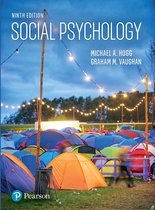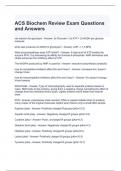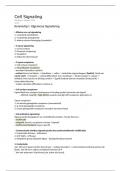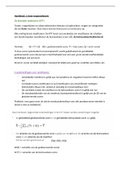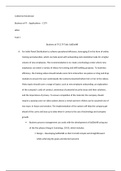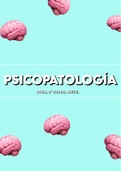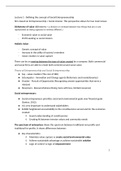TASK 1: SOCIAL COGNITON SOCIAL BEHAVIOUR
Social Cognition – cognitive processes and structures that influence and are influenced by social behaviour.
Subjective experiences of people (prior knowledge & experience)
Behaviourism: systematic approach to understanding behaviour of humans and other animals
Attribution: process of assigning a cause to our own behaviour and that of others
Gestalt psychology: social behaviour is a function of people’s perceptions and their manipulations of their
perceptions = cognition and thought in centre. Modes of social cognition:
1. Cognitive consistency: motivation to reduce discrepancy between cognitions(dissonance)
2. Naïve scientist: motivation to attribute causes to behaviour in order to make the world a meaningful
place in which to act. (Rational/scientific analyses to understand world)
3. Cognitive misers: (absence of motivation) people using least complex cognitions
4. Motivated tactician: people using multiple cognitive strategies. Choice depending on personal goals,
motives and needs.
How we form attributions about others =
Attribution Theory Explanation
Naïve There are two ways to interpret a situation
psychologist • Internal/dispositional attribution
theory • External/situational attribution
Correspondent How we make an internal attribution (correspondent inference) to someone’s
inference theory behaviour (5 cues)
• Act was freely chosen
• Act produced a non-common effect (outcome bias)
• Act was not socially desirable
• Hedonic relevance (act has direct impact on us)
• High in personalism (act seemed intended to affect us)
Kelley’s Principle to decide whether to attribute a behaviour internally or externally
attribution theory / • Consistency (How consistent is the reaction to the stimulus?)
Covariation model • Distinctiveness (Is the reaction limited to the specific stimulus?)
• Consensus (Is the reaction common or unique?)
Wieners Theory about the causes and consequences of the sort of attribution made for
Attributional people’s success or failure on a task
theory • Locus (can the performance be attributed internally or externally?)
• Stability (Is the internal or external cause stable or unstable?)
• Controllability (to what extent is the future task performance under the
actors control?)
How we form attributions about our selves =
Self-perception theory – we gain knowledge about ourselves only by making self-attributions
Attributional Biases
Self-serving biases Attributional distortions that protect or enhance self-esteem or the self-
concept
Self-handicapping – publicly making external attributions for our failure in
forthcoming event
Illusion of control – belief that we have more control over our world than
we really do
Belief in a just world – people deserve what they get
Intergroup Process of assigning the cause of one’s own behaviour to group membership
attributions Ethnocentrism – evaluative preference for all aspects of our own group
relative to other groups
1
, Ultimate attribution error – tendency to attribute bad outgroup behaviour
and good in-group behaviour internally and vice versa
Correspondence People have a tendency to attribute other’s behaviour internally (also known
bias as fundamental attribution error)
Cognitive miser Using the least complex cognitions to produce adaptive behaviour
(heuristics)
Motivated People chose their cognitive strategies based on their personal goals motives
tactician and needs
Essentialism Behaviour is considered to reflect underlying and immutable, often innate
properties of people or the groups they belong to
Outcome bias belief that the outcomes of a behaviour were intended by the person who
chose the behaviour
Actor observer Tendency to attribute our own behaviour externally and other’s behaviour
effect internally. It makes their behaviour more stable and predictable
False consensus Seeing our own behaviour as more typical than it really is
effect
Impression formation
Solomon Asch’s (1946) Configural model of impression formation
• Central traits – big influence over final impression (warm/cold) context/correlation dependent
• Peripheral traits – insignificant influence over final impression (blunt/polite)
Biases in forming impressions
Primacy effect earlier presented information has bigger influence on social cognition
Recency effect later presented information has a bigger influence on social cognition
Positivity absence of information leads us to assume the best
Negativity negative information receives more significance than positive information
Personal Personal way to characterise people due to preferences for instance.
constructs Adaptive forms of person perception and resistant to change
Implicit General assumptions what characteristics go together, shared within cultures
personality but differ between cultures
theories
Physical Physical appearance is very influential; we assume attractive people to be
appearance counts nice
Stereotypes Widely shared assumptions about the people with certain group
memberships
Social judgeability Perception of whether it’s socially acceptable to judge a specific target
Categorisation and Schemas
Categories – collection of instances with family resemblance, fuzzy sets around a prototype
Prototypes – cognitive representation of the typical or ideal defining features of the category
Exemplars – specific instances of a member of a category
• Inclusive and exclusive categories, people rely on basic-level categories (optimally distinctive). (bird,
table which van be divided in more (hawks and dining table) but not in bigger ones)
• Categories can be represented in associative networks – nodes are connected by associative links along
which cognitive activation can spread (bacon and eggs)
• Responsible for stereotyping – accentuation principle – we accentuate/exaggerate similarities within and
differences between groups
2
,Schema – cognitive structure that represents knowledge about a stimulus, activated by cues the schema fills in
missing knowledge
• Quickly make sense of a situation, use of prior knowledge rather than information from the source
The most common Types of schemas
• Person schemas – knowledge
structure about a specific
person
• Role schemas – knowledge
structures about role occupants
• Scripts – schemas about events
• Content-free schemas – rules for
information processing
• Self-schemas – part of people’s self-
concept
Schema use:
• If the costs of being wrong are high
people are more attentive to
data/use accurate schemas
• Costs of being indecisive
increase schema use, focus on
quick decisions rather than
accurate
• Accessibility
Acquiring and developing schemas
• In general schemas are acquired by encounters with category instances but we can acquire them second
hand (hear-say, media)
• As more instances are encountered schemas become more abstract, complex, compact, resilient and
accurate
Changing Schemas: schemas are relatively resistant to information that disconfirms them but there are three
ways of change
• Bookkeeping – slow change in face of accumulated evidence against the schema
• Conversion – sudden, massive change once enough evidence has been accumulated
• Subtyping – form a subcategory to accommodate disconfirming evidence
Schemas are more likely to change if they are logically or practically disconformable
Social encoding = process whereby external social stimuli are represented in the mind of the individual. 4 key
stages:
• Pre-attentive analysis – automatic, non-conscious scanning of the environment
• Focal attention – once noticed, stimuli are consciously identified and categorised
• Comprehension – stimuli are given meaning
• Elaborate reasoning – the stimulus is linked to other knowledge
Social encoding depends on what captures our attention influenced by three factors
• Salience: property of stimulus that makes it stand out in relation to other stimuli. (Novel or figural;
unexpected behaviour, important for our goal, dominant visual field)
• Vividness: property of stimulus on its own that makes it stand out (emotionally interesting, concrete and
image provoking, close to you in time and place)
• Accessibility (priming – activation of accessible categories/schemas that influence information
processing)
Memory for people
• We store information about people in associative networks
3
, • Inconsistent information attracts our attention more than consistent information with our impression
(generates more cognition and thought)
Contents of person memory
• We store information that is directly observable like appearance and behaviour and traits that are not
directly observable but based on inferences from behaviour and situations
Organising Person memory
• In general, we remember people as a cluster of information about their traits, behaviour and appearance,
However, we can also cluster people under attributes or groups
Social Inference = process of forming impressions (conclusions), we process social information in two ways
• Rely automatically on schemas or stereotypes – top down deductive (general -> specific)
• We can deliberately rely on specific instances in a bottom-up inductive way (specific -> general)
• Normative model: ideal processes for making accurate social inferences
Elaboration-likelihood model Heuristic-systematic model
Central route processing – careful and People process information carefully and
deliberate consideration of information systematically or rather automatically they rely
Peripheral route processing – rapid decision on cognitive heuristics (short-cuts)
based on schemas and stereotypes
Regression – initial observations form a category are more extreme, the more instances occur the less extreme
it becomes (regression to the mean)
Base-rate information – naturally occurring frequency of a phenomenon in population
Illusory correlation – people assume relationships between two variables were no exists or exaggerate the
correlation
Associative meaning - items are seen as belonging together because they ought to, on the basis of prior
expectations
Paired distinctiveness - items are thought to go together because they share some unusual features
Heuristics = Cognitive shortcuts that provide adequately accurate information most of the time (use less
capacity)
- Representative heuristic – which instances are assigned to categories or types on the basis of overall
similarity or resemblance to the category (Singers are attractive)
- Availability heuristics – overestimation of the likelihood because of frequency in the media
(accessibility)
- Anchoring and adjustment – inferences are tied to initial standard or schema, the anchor is our self-
schema
Affect and Emotion
Cognitive appraisal – interpretation of situation influences behaviour
Affective response (emotion) – mode of action readiness, appraisal process is continuous and largely
automatic, rests two appraisal dimensions (primary and secondary)
Primary appraisals – perception of a situation as beneficial/irrelevant and good/bad
Secondary appraisals – relates to accountability and coping (response)
Affect-infusion model – cognition is influenced by emotional state (affect)
Four ways in which people can process information about one another
• Direct access – directly access schemas stored in memory
• Motivated processing – form judgement on the basis of a specific motivation
• Heuristic processing – rely on heuristics (shortcuts)
• Substantive processing – form a judgement from informational sources
E-READER:
4
Social Cognition – cognitive processes and structures that influence and are influenced by social behaviour.
Subjective experiences of people (prior knowledge & experience)
Behaviourism: systematic approach to understanding behaviour of humans and other animals
Attribution: process of assigning a cause to our own behaviour and that of others
Gestalt psychology: social behaviour is a function of people’s perceptions and their manipulations of their
perceptions = cognition and thought in centre. Modes of social cognition:
1. Cognitive consistency: motivation to reduce discrepancy between cognitions(dissonance)
2. Naïve scientist: motivation to attribute causes to behaviour in order to make the world a meaningful
place in which to act. (Rational/scientific analyses to understand world)
3. Cognitive misers: (absence of motivation) people using least complex cognitions
4. Motivated tactician: people using multiple cognitive strategies. Choice depending on personal goals,
motives and needs.
How we form attributions about others =
Attribution Theory Explanation
Naïve There are two ways to interpret a situation
psychologist • Internal/dispositional attribution
theory • External/situational attribution
Correspondent How we make an internal attribution (correspondent inference) to someone’s
inference theory behaviour (5 cues)
• Act was freely chosen
• Act produced a non-common effect (outcome bias)
• Act was not socially desirable
• Hedonic relevance (act has direct impact on us)
• High in personalism (act seemed intended to affect us)
Kelley’s Principle to decide whether to attribute a behaviour internally or externally
attribution theory / • Consistency (How consistent is the reaction to the stimulus?)
Covariation model • Distinctiveness (Is the reaction limited to the specific stimulus?)
• Consensus (Is the reaction common or unique?)
Wieners Theory about the causes and consequences of the sort of attribution made for
Attributional people’s success or failure on a task
theory • Locus (can the performance be attributed internally or externally?)
• Stability (Is the internal or external cause stable or unstable?)
• Controllability (to what extent is the future task performance under the
actors control?)
How we form attributions about our selves =
Self-perception theory – we gain knowledge about ourselves only by making self-attributions
Attributional Biases
Self-serving biases Attributional distortions that protect or enhance self-esteem or the self-
concept
Self-handicapping – publicly making external attributions for our failure in
forthcoming event
Illusion of control – belief that we have more control over our world than
we really do
Belief in a just world – people deserve what they get
Intergroup Process of assigning the cause of one’s own behaviour to group membership
attributions Ethnocentrism – evaluative preference for all aspects of our own group
relative to other groups
1
, Ultimate attribution error – tendency to attribute bad outgroup behaviour
and good in-group behaviour internally and vice versa
Correspondence People have a tendency to attribute other’s behaviour internally (also known
bias as fundamental attribution error)
Cognitive miser Using the least complex cognitions to produce adaptive behaviour
(heuristics)
Motivated People chose their cognitive strategies based on their personal goals motives
tactician and needs
Essentialism Behaviour is considered to reflect underlying and immutable, often innate
properties of people or the groups they belong to
Outcome bias belief that the outcomes of a behaviour were intended by the person who
chose the behaviour
Actor observer Tendency to attribute our own behaviour externally and other’s behaviour
effect internally. It makes their behaviour more stable and predictable
False consensus Seeing our own behaviour as more typical than it really is
effect
Impression formation
Solomon Asch’s (1946) Configural model of impression formation
• Central traits – big influence over final impression (warm/cold) context/correlation dependent
• Peripheral traits – insignificant influence over final impression (blunt/polite)
Biases in forming impressions
Primacy effect earlier presented information has bigger influence on social cognition
Recency effect later presented information has a bigger influence on social cognition
Positivity absence of information leads us to assume the best
Negativity negative information receives more significance than positive information
Personal Personal way to characterise people due to preferences for instance.
constructs Adaptive forms of person perception and resistant to change
Implicit General assumptions what characteristics go together, shared within cultures
personality but differ between cultures
theories
Physical Physical appearance is very influential; we assume attractive people to be
appearance counts nice
Stereotypes Widely shared assumptions about the people with certain group
memberships
Social judgeability Perception of whether it’s socially acceptable to judge a specific target
Categorisation and Schemas
Categories – collection of instances with family resemblance, fuzzy sets around a prototype
Prototypes – cognitive representation of the typical or ideal defining features of the category
Exemplars – specific instances of a member of a category
• Inclusive and exclusive categories, people rely on basic-level categories (optimally distinctive). (bird,
table which van be divided in more (hawks and dining table) but not in bigger ones)
• Categories can be represented in associative networks – nodes are connected by associative links along
which cognitive activation can spread (bacon and eggs)
• Responsible for stereotyping – accentuation principle – we accentuate/exaggerate similarities within and
differences between groups
2
,Schema – cognitive structure that represents knowledge about a stimulus, activated by cues the schema fills in
missing knowledge
• Quickly make sense of a situation, use of prior knowledge rather than information from the source
The most common Types of schemas
• Person schemas – knowledge
structure about a specific
person
• Role schemas – knowledge
structures about role occupants
• Scripts – schemas about events
• Content-free schemas – rules for
information processing
• Self-schemas – part of people’s self-
concept
Schema use:
• If the costs of being wrong are high
people are more attentive to
data/use accurate schemas
• Costs of being indecisive
increase schema use, focus on
quick decisions rather than
accurate
• Accessibility
Acquiring and developing schemas
• In general schemas are acquired by encounters with category instances but we can acquire them second
hand (hear-say, media)
• As more instances are encountered schemas become more abstract, complex, compact, resilient and
accurate
Changing Schemas: schemas are relatively resistant to information that disconfirms them but there are three
ways of change
• Bookkeeping – slow change in face of accumulated evidence against the schema
• Conversion – sudden, massive change once enough evidence has been accumulated
• Subtyping – form a subcategory to accommodate disconfirming evidence
Schemas are more likely to change if they are logically or practically disconformable
Social encoding = process whereby external social stimuli are represented in the mind of the individual. 4 key
stages:
• Pre-attentive analysis – automatic, non-conscious scanning of the environment
• Focal attention – once noticed, stimuli are consciously identified and categorised
• Comprehension – stimuli are given meaning
• Elaborate reasoning – the stimulus is linked to other knowledge
Social encoding depends on what captures our attention influenced by three factors
• Salience: property of stimulus that makes it stand out in relation to other stimuli. (Novel or figural;
unexpected behaviour, important for our goal, dominant visual field)
• Vividness: property of stimulus on its own that makes it stand out (emotionally interesting, concrete and
image provoking, close to you in time and place)
• Accessibility (priming – activation of accessible categories/schemas that influence information
processing)
Memory for people
• We store information about people in associative networks
3
, • Inconsistent information attracts our attention more than consistent information with our impression
(generates more cognition and thought)
Contents of person memory
• We store information that is directly observable like appearance and behaviour and traits that are not
directly observable but based on inferences from behaviour and situations
Organising Person memory
• In general, we remember people as a cluster of information about their traits, behaviour and appearance,
However, we can also cluster people under attributes or groups
Social Inference = process of forming impressions (conclusions), we process social information in two ways
• Rely automatically on schemas or stereotypes – top down deductive (general -> specific)
• We can deliberately rely on specific instances in a bottom-up inductive way (specific -> general)
• Normative model: ideal processes for making accurate social inferences
Elaboration-likelihood model Heuristic-systematic model
Central route processing – careful and People process information carefully and
deliberate consideration of information systematically or rather automatically they rely
Peripheral route processing – rapid decision on cognitive heuristics (short-cuts)
based on schemas and stereotypes
Regression – initial observations form a category are more extreme, the more instances occur the less extreme
it becomes (regression to the mean)
Base-rate information – naturally occurring frequency of a phenomenon in population
Illusory correlation – people assume relationships between two variables were no exists or exaggerate the
correlation
Associative meaning - items are seen as belonging together because they ought to, on the basis of prior
expectations
Paired distinctiveness - items are thought to go together because they share some unusual features
Heuristics = Cognitive shortcuts that provide adequately accurate information most of the time (use less
capacity)
- Representative heuristic – which instances are assigned to categories or types on the basis of overall
similarity or resemblance to the category (Singers are attractive)
- Availability heuristics – overestimation of the likelihood because of frequency in the media
(accessibility)
- Anchoring and adjustment – inferences are tied to initial standard or schema, the anchor is our self-
schema
Affect and Emotion
Cognitive appraisal – interpretation of situation influences behaviour
Affective response (emotion) – mode of action readiness, appraisal process is continuous and largely
automatic, rests two appraisal dimensions (primary and secondary)
Primary appraisals – perception of a situation as beneficial/irrelevant and good/bad
Secondary appraisals – relates to accountability and coping (response)
Affect-infusion model – cognition is influenced by emotional state (affect)
Four ways in which people can process information about one another
• Direct access – directly access schemas stored in memory
• Motivated processing – form judgement on the basis of a specific motivation
• Heuristic processing – rely on heuristics (shortcuts)
• Substantive processing – form a judgement from informational sources
E-READER:
4

